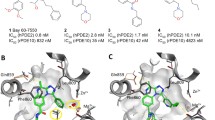Summary
Ligands which bind to a specific protein binding site are often expected to have a similar electrostatic environment which complements that of the binding site. One method of assessing molecular electrostatic similarity is to examine the possible overlay of the maxima and minima in the electrostatic potential outside the molecules and thereby match the regions where strong electrostatic interactions, including hydrogen bonds, with the residues of the binding site may be possible. This approach is validated with accurate calculations of the electrostatic potential, derived from a distributed multipole analysis of an ab initio charge density of the molecule, so that the effects of lone pair and π-electron density are correctly included. We have applied this method to the phosphodiesterase (PDE) III substrate adenosine-3′,5′-cyclic monophosphate (cAMP) and a range of nonspecific and specific PDE III inhibitors. Despite the structural variation between cAMP and the inhibitors, it is possible to match three or four extrema to produce relative orientations in which the inhibitors are sufficiently sterically and electrostatically similar to the natural substrate to account for their affinity for PDE III. This matching of extrema is more apparent using the accurate electrostatic models than it was when this approach was first applied, using semiempirical point charge models. These results reinforce the hypothesis of electrostatic similarity and give weight to the technique of extrema matching as a useful tool in drug design.
Similar content being viewed by others
References
Weinstein, H., Osman, R., Topiol, S. and Green, A.P., Ann. New York Acad. Sci., 367 (1981) 434.
Weinstein, H., Osman, R., Green, J.P. and Topiol, S., In Politzer, P. and Truhlar, D.G. (Eds.) Chemical Applications of Atomic and Molecular Electrostatic Potentials, Plenum Press, New York, NY, 1981, pp. 309–334.
Carbo, R., Leyda, L. and Arnau, M., Int. J. Quantum Chem., 17 (1980) 1185.
Hodgkin, E.E. and Richards, W.G., Int. J. Quantum Chem., Quantum Biol. Symp., 14 (1987) 105.
van der Wenden, E.M., Price, S.L., Apaya, R.P., IJzerman, A.P. and Soudijn, W., J. Comput.-Aided Mol. Design, 9 (1995) 44.
Sanz, F., Manaut, F., Rodríguez, J., Lozoya, E. and López-de-Briñas, E., J. Comput.-Aided Mol. Design, 7 (1993) 337.
Davis, A., Warrington, B.H. and Vinter, J.G., J. Comput.-Aided Mol. Design, 1 (1987) 97.
Stone, A.J. and Alderton, M., Mol. Phys., 56 (1985) 1047.
Buckingham, A.D. and Fowler, P.W., Can. J. Chem., 63 (1985) 2018.
Kato, Y., Inoue, A., Yamada, M., Tomioka, N. and Itai, A., J. Comput.-Aided Mol. Design, 6 (1992) 475.
Moos, W.H., Humblet, C.C., Sircar, I., Rithner, C., Weishaar, R.E., Bristol, J.A. and McPhail, A.T., J. Med. Chem., 30 (1987) 1963.
MacroModel, Version 3.1, Columbia University, New York, NY, 1990.
Weiner, S.J., Kollman, P.A., Nguyen, D.T. and Case, D.A., J. Comput. Chem., 7 (1986) 230.
Bristol, J.A., Sircar, I., Moos, W.H., Evans, D.B. and Weishaar, R.E., J. Med. Chem. 27 (1984) 1099.
Prout, K., Bannister, C., Burns, K., Chen, M., Warrington, B.H. and Vinter, J.G., Acta Crystallogr., B50 (1994) 71.
Robertson, D.W., Beedle, E.E., Swartzendruber, J.K., Jones, N.D., Elzey, T.K., Kauffmann, R.F., Wilson, H. and Hayes, J.S., J. Med. Chem.,29 (1986) 635.
CADPAC5: The Cambridge Analytical Derivatives Package, Issue 5.0, 1992, a suite of quantum chemistry programs developed by R.D. Amos with contributions from I.L. Alberts, J.S. Andrews, S.M. Colwell, N.C. Handy, D. Jayatilaka, P.J. Knowles, R. Kobayashi, N. Koga, K.E. Laidig, P.E. Malsen, C.W. Murray, J.E. Rice, J. Sanz, D. Simandiras, A.J. Stone and M.-D. Su.
Binkley, J.S., Pople, J.A. and Hehre, W.J., J. Am. Chem. Soc., 102 (1980) 939.
Price, S.L., Andrews, J.S., Murray, C.W. and Amos, R.D., J. Am. Chem. Soc., 114 (1992) 8268.
Stone, A.J., Chem. Phys. Lett., 83 (1981) 233.
Price, S.L. and Stone, A.J., J. Chem. Phys., 86 (1987) 2859.
Stone, A.J., ORIENT, Version 2, a program for calculating the electrostatic interactions between molecules, University of Cambridge, Cambridge, 1990.
Venuti, M.C., Stephenson, R.A., Alvarez, R., Bruno, J.J. and Strosberg, A.M., J. Med. Chem., 31 (1988) 2136.
Peet, N.P., Lentz, N.L., Meng, E.C., Dudley, M.W., Ogden, A.M.L., Demeter, D.A., Weintraub, H.J.R. and Bey, P., J. Med. Chem., 33 (1990) 3127.
Price, S.L. and Stone, A.J., J. Chem. Soc., Faraday Trans., 88 (1992) 1755.
Vinter, J.G., J. Comput.-Aided Mol. Design, 8 (1994) 653.
Author information
Authors and Affiliations
Rights and permissions
About this article
Cite this article
Apaya, R.P., Lucchese, B., Price, S.L. et al. The matching of electrostatic extrema: A useful method in drug design? A study of phosphodiesterase III inhibitors. J Computer-Aided Mol Des 9, 33–43 (1995). https://doi.org/10.1007/BF00117276
Received:
Accepted:
Issue Date:
DOI: https://doi.org/10.1007/BF00117276




